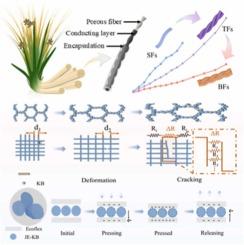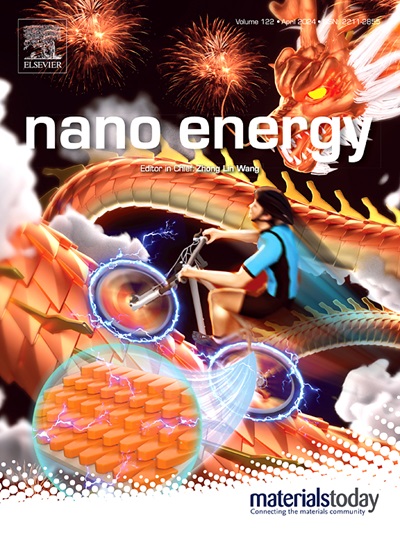Wide response stretchable sensors by stress distribution control of multi-structure for hand motion monitoring and energy harvesting
IF 17.1
1区 材料科学
Q1 CHEMISTRY, PHYSICAL
引用次数: 0
Abstract
With the growing demand for wearable electronics, a variety of flexible strain sensors have made booming development. However, achieving good linearity and wide sensing range based on stress distribution controls for flexible strain sensors in an economical manner is still a challenge. Herein, combining mature textile processing methods, three strain sensors based on stress distribution to balance the sensitivity-stretchability contradiction have been fabricated. A porous fiber-based stretchable strain sensor with a unique conductive pathway consisting of a three-dimensional (3D) fiber skeleton of Juncus effusus (JE) and Ketjen black (KB) particles embedded on the surface was presented. The obtained JE-based strain sensor exhibits advanced characteristics of good sensitivity (GF = 7.09) and durability (> 2000 cycles). Secondly, two novel strain sensors were prepared by mature textile methods to extend their sensing range (> 180 %). All three sensors have been demonstrated to have favorable linearity and stability, making them selectable based on specific application requirements. Furthermore, the developed JE-based sensors demonstrate strong potential for energy harvesting, capable of generating an average voltage of 65.5 V and a power output of 82.3 μW. Such the prepared sensors with favorable linearity and a wide sensing range based on stress distribution controls demonstrate potential applications for hand motion monitoring and energy harvesting in wearable electronics.

基于应力分布控制的多结构宽响应可拉伸传感器用于手部运动监测和能量采集
随着人们对可穿戴电子产品需求的不断增长,各种柔性应变传感器得到了蓬勃发展。然而,如何以经济的方式实现基于应力分布控制的柔性应变传感器的良好线性度和宽传感范围仍然是一个挑战。在此基础上,结合成熟的纺织品加工方法,制作了三种基于应力分布的应变传感器,以平衡灵敏度与拉伸性的矛盾。提出了一种基于多孔纤维的可拉伸应变传感器,该传感器具有独特的导电路径,该路径由积液Juncus effusus (JE)的三维(3D)纤维骨架和嵌入表面的Ketjen black (KB)颗粒组成。所获得的基于je的应变传感器具有良好的灵敏度(GF = 7.09)和耐久性(>;2000周期)。其次,采用成熟的纺织方法制备了两种新型应变传感器,以扩大其传感范围(>;180%)。所有三种传感器已被证明具有良好的线性和稳定性,使其可根据特定的应用要求进行选择。此外,开发的基于je的传感器显示出强大的能量收集潜力,能够产生65.5 V的平均电压和82.3 μW的输出功率。这种基于应力分布控制的传感器具有良好的线性度和广泛的传感范围,在可穿戴电子设备的手部运动监测和能量收集方面具有潜在的应用前景。
本文章由计算机程序翻译,如有差异,请以英文原文为准。
求助全文
约1分钟内获得全文
求助全文
来源期刊

Nano Energy
CHEMISTRY, PHYSICAL-NANOSCIENCE & NANOTECHNOLOGY
CiteScore
30.30
自引率
7.40%
发文量
1207
审稿时长
23 days
期刊介绍:
Nano Energy is a multidisciplinary, rapid-publication forum of original peer-reviewed contributions on the science and engineering of nanomaterials and nanodevices used in all forms of energy harvesting, conversion, storage, utilization and policy. Through its mixture of articles, reviews, communications, research news, and information on key developments, Nano Energy provides a comprehensive coverage of this exciting and dynamic field which joins nanoscience and nanotechnology with energy science. The journal is relevant to all those who are interested in nanomaterials solutions to the energy problem.
Nano Energy publishes original experimental and theoretical research on all aspects of energy-related research which utilizes nanomaterials and nanotechnology. Manuscripts of four types are considered: review articles which inform readers of the latest research and advances in energy science; rapid communications which feature exciting research breakthroughs in the field; full-length articles which report comprehensive research developments; and news and opinions which comment on topical issues or express views on the developments in related fields.
 求助内容:
求助内容: 应助结果提醒方式:
应助结果提醒方式:


